By Saul Kaplan, on Mon Apr 7, 2014 at 8:30 AM ET 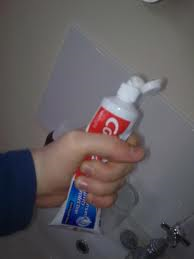 Here’s the thing about toothpaste tubes. You can squeeze all you want on one part of the tube and the toothpaste will only pop up in another part of the tube. Many of today’s important systems operate much the same way. Here’s the thing about toothpaste tubes. You can squeeze all you want on one part of the tube and the toothpaste will only pop up in another part of the tube. Many of today’s important systems operate much the same way.
The big challenges we face today including health care and education are systems issues that require systems solutions. These systems have evolved over a long time and are well intentioned. Players in the system work hard year after year to deliver value, improve their position, and create sustained incremental improvements. It is not enough. We need new toothpaste tubes. We can’t fix these system issues by squeezing harder on different parts of the tube. We need to design and experiment with new system level solutions.
Everyone loves to point fingers at the other players in the system as the cause of the problem. Health care is a classic example. Observing our health care system today is like watching an intense rugby scrum that is moving in slow motion hoping the ball will pop out. Finger pointing and incessant public policy debates galore. We love to admire the problems: It is the cost of drugs that is killing us. It is the high cost hospitals that are the problem. It is the insurance companies that are in the way of change. Doctors are the ones who are resisting change. If only the government would get its act together. If only patients would take more responsibility for their care. It goes on and on.
In education, the same movie is playing with different actors. It’s the unions that are getting in the way. Teachers are resisting change in the classroom. Administrators don’t understand what is going on in the classroom. Parents are not engaged. Public policy makers can’t make up their minds. If only private sector companies were more engaged. Students are unruly, undisciplined, and disrespectful. Everyone is blamed and nothing changes.
I’m not a cynic. I’ve seen and participated in many innovative initiatives that are trying to create systems-level changes within healthcare and education. And some of them have indeed succeeded in creating incremental value. But where are the disrupters? Where are the systems-level game changers? The problem is that great ideas coming from one silo are tried but quickly bump into the other silos and constraints of the system. Promising new solutions squeeze on one part of the toothpaste tube only to learn that when you squeeze on one part of the tube it just pops up in another. We need safe environments to design and experiment with new toothpaste tubes or systems.
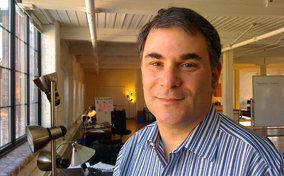 The student and the patient should be at the center of our redesign efforts in education and health care. We need to experiment at the systems level, trying new approaches to see what works. For instance, we’ve proven that innovation works at the school level with hundreds of successful charter schools across the country. Now we need to experiment at the district level to test new student centered system approaches that are not constrained by the way the current system operates. That is the only way we are going to learn what solutions can deliver value to the student at scale. The same thing is true in health care. We need to design and test patient centered system approaches that are more about well care than about sick care. We can’t get there by playing at the margins of today’s system. Squeezing today’s toothpaste tubes harder will not work. The student and the patient should be at the center of our redesign efforts in education and health care. We need to experiment at the systems level, trying new approaches to see what works. For instance, we’ve proven that innovation works at the school level with hundreds of successful charter schools across the country. Now we need to experiment at the district level to test new student centered system approaches that are not constrained by the way the current system operates. That is the only way we are going to learn what solutions can deliver value to the student at scale. The same thing is true in health care. We need to design and test patient centered system approaches that are more about well care than about sick care. We can’t get there by playing at the margins of today’s system. Squeezing today’s toothpaste tubes harder will not work.
By Saul Kaplan, on Mon Mar 31, 2014 at 8:30 AM ET Everyone bows down to the all, important benchmark. How many times have you heard someone say, “You only get what you measure”? Most organizations commit to identifying and measuring performance against industry best practice. Many have recognized the value of looking outside of their industry for practices that might provide a source of competitive advantage. Adopting existing best practice makes sense if you want to improve the performance of your current business model. Going beyond the limits of your current business model requires a network-enabled capability to do R&D for new business models. The imperative is to build on best practices to explore and develop next practices.
Understanding best practices and applying them to increase business model productivity is an essential capability for all organizations. No surprise most companies benchmark their performance adopting practices ranging from accessing benchmarking data to sourcing (internal and external) process improvement capabilities. Like all learned behaviors the earlier it is adopted the easier it is to scale and to apply in other markets. Entrepreneurs and small business leaders should start with a back of the napkin approach. Be specific about goals and take the napkin out a lot.
It doesn’t take long to exhaust the library of best practices in any given industry. Field organizations have seen most of what the competition is doing and can report their observations. In addition your customers and networks have an important perspective that should be tapped. Social network platforms, like Twitter, Facebook, and Linked-in make real time information interaction possible across networks. Leverage these new tools and platforms. It is worth it.
 Only exploring your own industry for best practices is limiting. New sources of competitive advantage are far more likely to come from observing and adopting best practices in completely unrelated industries. All leaders should spend more discretionary time outside of their industry, discipline, and sector. There is more to learn from unusual suspects who bring fresh and different perspectives than from the ideas circulated and re-circulated among the usual suspects. The big and important value creating opportunities will most likely be found in the gray areas between the silos we inhabit. Get out more. Only exploring your own industry for best practices is limiting. New sources of competitive advantage are far more likely to come from observing and adopting best practices in completely unrelated industries. All leaders should spend more discretionary time outside of their industry, discipline, and sector. There is more to learn from unusual suspects who bring fresh and different perspectives than from the ideas circulated and re-circulated among the usual suspects. The big and important value creating opportunities will most likely be found in the gray areas between the silos we inhabit. Get out more.
Best practices are necessary but not sufficient. Business models don’t last as long as they used to. Leaders must identify and experiment with next practices. Next practices enable new ways to deliver customer value. Next practices are better ways to combine and network capabilities that change the value equation of your organization. Organizations should always be developing a portfolio of next practices that recombine capabilities to find new ways to deliver value. Leaders should design and test new business models unconstrained by the current business or industry model.
It is easy to sketch out business model innovation scenarios on the white board. It is far more difficult to take the idea off the white board for a spin in the real world. We need safe and manageable platforms for real world experimentation of new business models and systems. Since most leaders in the 21st century will likely have to change their business models several times over their careers it makes sense to do R&D for new business models the same way R&D is done for new products and technologies today. Create the space for exploration.
It is not best practices, but next practices that will sustain your organization on a strong growth trajectory. While you continue to pedal the bicycle of today’s business model make sure that no less than 10% of your time and resources is dedicated to exploring new business models and developing next practices.
By Julie Rath, on Fri Mar 28, 2014 at 8:30 AM ET 
No matter how tempting it might be to squeeze, dig or pick at a pimple, word life: don’t do it. It will only irritate the area and make it more likely to spread. Below is an anti-zit concoction I discovered a few years back, and it always comes through. It’s made up of items that are probably hanging around your kitchen already and is super easy to assemble.
Materials:
cotton swab
hydrogen peroxide
1/8 cup powdered oatmeal
1/2 tablespoon fresh lemon juice
1/4 c egg whites
3 drops honey
Directions:
1. Dab cotton swab in hydrogen peroxide and clean blemish area (this keeps the pimple from spreading).
2. Mix everything else in a small bowl to create a paste.
3. Cover pimple with mixture and leave on for twenty minutes.
4. Rinse with warm water.
5. Apply twice a day until zit disappears. (Leftovers will keep in fridge for up to one week.)
-Content provided by Rath & Co. Men’s Style Consulting. Read more: http://rathandco.com/2011/07/simple-home-blemish-treatment/#ixzz2vU55SVRk
By RP Nation, on Tue Mar 25, 2014 at 10:00 AM ET I am 27 years old. I can sugar-coat things by saying I am single, free-spirited, and full of optimism when really I live under the security blanket of those words. So let me be clear: I am alone. I am, at times, spirit-free. I am unemployed and more than I’d like to admit, feel the glass is half empty. Being honest and showing vulnerability is not to win some sort of Purple Heart, literary or otherwise. It is, justly and in fact, the truth.
I don’t want to earn or gain sympathy. Exercising my right to free speech and type will always bring the bearers of bleeding heart and bleating doubt. So it is essential that I assert through this brief dissertation that I have said and done these things by choice.
I have made many decisions that have led me to this fork in the road. I have no blame to point towards myself or others. I have no regrets either. Instead, I have nothing but time to learn. Quaint as my living quarters may be, the vast and unknown are things I am facing…as I should in my twenties. I have no doubt the evidence of struggle and the peace I find with this time in my life will line my pockets one day. I am, of course, the quintessential millennial with high hopes and dreams. The only question now is how.
It would be nice to contemplate my navel with this time away from the working world. I did for a couple of weeks after the hangover wore off from the perpetual hamster-spinning and mind cluster crap I became accustomed to in my previous position. Now, I only wish for an opportunity that would make the wheels in my brain turn, a new thought, a new idea, a break from the monotony, a way out…a paying job. At this point, it doesn’t have to be the job. Just A job.
There are moments in my wallows of self-pity that I do find comfort and the ability to think positively.
 I find being unattached at this juncture a blessing. I hear stories of those who have lost jobs and are working hard to provide for their families and I find my scenario as a single female and tiny dog in tow much less harrowing. He eats out of one bowl, poops outside, requires less attention and is always happy when I come home. Also he sleeps. A lot. It is my disturbed sleep schedule that puts a wrench in his day. I find being unattached at this juncture a blessing. I hear stories of those who have lost jobs and are working hard to provide for their families and I find my scenario as a single female and tiny dog in tow much less harrowing. He eats out of one bowl, poops outside, requires less attention and is always happy when I come home. Also he sleeps. A lot. It is my disturbed sleep schedule that puts a wrench in his day.
As free-spirited as I used to be as a younger tot (yes, Baby Boomers, there is a complete shift in mentality from the ages of 22-27…just go with it), I have become indebted and feel power from the responsibilities that keep me yearning for more. To meet a cute boy and hop on a tour bus at 27? Well, that’s stupid, painfully unaware, and desperate. I lived those days. I loved those days. Although I have time to spend on whatever my heart desires, my spirit leads me towards watching Tom Brokaw, not Tom Petty. The days of free falling are over. I loved them, I thank them for being in my life, and I don’t miss them. I like the news now.
I have learned by age and experience that it is also okay to not trust everyone, everything, and every situation. Sometimes it is okay to be a little weary. The glass may be half-empty at times because I realize there is a glass half-full waiting for me somewhere else. I would not trade the wisdom and the newfound ability to trust my gut for anything in the world. It has given me the most mature outlook on the world I have possessed thus far in my life – one that keeps me from diving in head first. I have learned to be patient and cautious enough to check the temperature of the water. I also avoid hot tubs. Another habit rid from the early twenties. I hear those things have lots of germs. Gross.
So I show this vulnerability. Why?
Didn’t you know? It’s the age of the Internet. People love to scan through this stuff and make judgments either in favor or in contempt. Or to give some other opinion that makes voicing it on the Internet a special experience for those deprived of human contact and self confidence. I am, at times, lacking in both as well. Why take to the vast and unknown and divulge my inner feelings? Again, Baby Boomers – it’s just what we do. Go with it.
I do know that I am not the only one. And I, along with many of my millennial brothers and sisters out there struggling to figure it all out, will have lined pockets one day after contemplating our belly buttons, watching educational programs, searching our souls, calming our too-free of spirits (sometimes), buckling down, earning – and loving – the next move in our journeys. Interesting enough – it won’t take Journey or Tom Petty, but we Don’t Stop Believing. We are resilient little twerps, aren’t we?
Career, life, and love are like really great bourbon. They’re fun when they’re young, but there is something sweet and powerful when they get a little age on ‘em.
Oh, and they’re more of a commodity – because they’ve grown to become something very special. The days of boxed wine and cheap seats are over for this gal. At least that’s the metaphor. I will be drinking boxed wine and looking on from the nosebleeds until I find a job to soothe the pockets…and then line them. Love? I assume that may be next.
Life? Well, that’s what I’ve had all along. I won’t be waiting for wrinkles to become special. This is one thing I’m confident of; a sweet gift I do have in my half-empty pocket that’s sure to surprise – Tom Brokaw and all.
By Saul Kaplan, on Mon Mar 24, 2014 at 8:30 AM ET Innovation is about a better way to deliver value. Innovators are all around us. They are taking advantage of today’s technologies and creating new ways to deliver value. We can learn from them if we look up from our silos.
Sometimes the most inspiring innovators are in places we would never have thought to look. Or perhaps we just don’t notice them because our attention is focused on the inventors of new technologies or the entrepreneurs who are making progress in bringing inventions to market. Those people are important but not the whole story.
Meet the plumber and the police chief.
Anthony Gemma is president of Gem Plumbing in Lincoln, R.I. Together with his brothers, Anthony runs one of the most innovative businesses I have seen. I didn’t expect it when I first visited the company. After all, how innovative can a plumbing supply company be? The answer is very innovative.
Gem is on a mission to win the Baldrige National Quality Award. I believe they will achieve it. They have established a culture of excellence and innovation in every aspect of their regional business. They collect, analyze and share data ranging from the location of every part — from the supplier to the service truck to the home — to how long a customer waits to talk live to the dispatcher on the phone. They benchmark themselves against the best. Not the best plumbing supply company, the best companies.
Gem’s customer call and dispatch center would blow you away. It is like standing in NASA mission control. On 12-foot monitoring screens they have live feeds of real-time traffic conditions and satellite mapping of every service vehicle. If there is available capacity in the fleet, Gem is placing a customized radio ad to create tailored demand. They are so good at tracking traffic conditions they supply information to the Department of Transportation and local radio stations for traffic reports.
 Their business grew from $9 million in 1999 to $40 million in 2007. They get so many businesses coming in for tours and information about their innovation programs they set up the Gem Institute for Performance Excellence. Who would have thought to look at a regional plumbing supply company as an example of innovation best practices? Their business grew from $9 million in 1999 to $40 million in 2007. They get so many businesses coming in for tours and information about their innovation programs they set up the Gem Institute for Performance Excellence. Who would have thought to look at a regional plumbing supply company as an example of innovation best practices?
Next, meet Dean Esserman, chief of police in Providence, R.I. When he was hired by Mayor David Cicilline in 2003, Esserman found a city where the crime rates were high and a force that was troubled by corruption and distrusted by the community. People were afraid to travel downtown. What he’s done since is a great story of business model innovation, and he has delivered significant value to the citizens of Providence.
In six years, Esserman transformed the Providence policing model from a centralized department where police were anonymous and came to the neighborhood after receiving a 911 call to a decentralized department with neighborhood substations and district commanders who are accountable for crime in the local community. His philosophy is that when police get out of their cars and into the life of a neighborhood they become trusted allies.
I have attended the chief’s regular Tuesday morning command meetings where a sophisticated crime tracking system displays crime statistics by district. Each commander is called upon to talk about crime activity in their district and what they are doing about it. The new business model is working, with double digit declines in the overall Providence crime rate. Who would have thought to look at a police chief as an example of innovation best practices?
The plumber and the police chief are just two examples of the innovators among us. Examples are everywhere. We just have to look in the places that we would least expect to find them.
By Jonathan Miller, on Thu Mar 20, 2014 at 1:50 PM ET 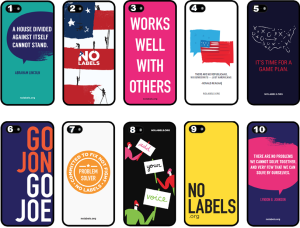 Nearly 100 brave souls signed up to compete in the third annual Recovering Politician/No Labels NCAA basketball tournament prediction contest, No Bracket, No Pay. Nearly 100 brave souls signed up to compete in the third annual Recovering Politician/No Labels NCAA basketball tournament prediction contest, No Bracket, No Pay.
(The name comes from No Labels’ signature proposal, “No Budget, No Pay,” the simple proposition that if Congress doesn’t perform its constitutional duty to pass a budget, they shouldn’t get paid. Click here to learn more about No Labels, and here to learn about “No Budget, No Pay”).
Today, we announce the fabulous prizes to be awarded to the winners of this free contest:
1. The top prize — for the person who earns the most points through being the best predictor of the entire bracket, wins the new No Labels iPhone case. What does it look like? Well, take a look at the finalists above and vote on your favorite by clicking here.
2. Everyone who correctly predicts the NCAA Champion, but doesn’t win the entire contest, will receive a No Labels car magnet!
So good luck to all, and in the interim, help us decide on the best iPhone case.
By Jonathan Miller, on Wed Mar 19, 2014 at 9:00 AM ET 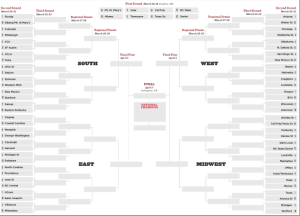 Click here for a printable 2014 NCAA Bracket You have only about 15 more hours to sign up for year three of “No Bracket, No Pay” — The Recovering Politician’s contest for college hoops forecasting mastery. Just click here to signup, and fill our your brackets before TONIGHT at Midnight.
Our first two years were spectacular successes — not only did over 150 people compete, but two of my home state teams, the University of Kentucky Wildcats and the University of Louisville Cardinals, won the national championship. Better yet, “No Budget, No Pay” — the hallmark policy proposal of our co-sponsor, No Labels — passed through Congress and became law. All because of our hoops competition! (OK, maybe the cause and effect was a little tenuous.)
Stay tuned to read about the fabulous prizes that we will be offering.
Anyway, you are invited to join us in No Bracket, No Pay III. Simply click here to signup, and fill our your brackets before Wednesday night at Midnight.
Good luck!
By Lauren Mayer, on Wed Mar 19, 2014 at 8:30 AM ET One of the advantages of being a teenager’s mother (no, really, there ARE some advantages!) is early knowledge of trends. And it’s not just obsessive texting, video games, or mindless cat videos – my boys both introduced me to the wealth of actual, useful information one can find on youTube. (Although there’s plenty of ridiculous filler – as one comedian observed, we could just combine the youTube, Twitter and Facebook into one giant time-wasting site called “youTwitFace” . . . but I digress.)
My tap-dancer son has shown me great archival footage of the legends he admires, and youTube has introduced a whole new generation to the genius of Bill Robinson, Eleanor Powell, and the Nicholas Brothers. My younger son is a fan of cool science experiments as well as a group that does brilliant out-of-the-box music routines (including one in which a group of musicians created a piece by playing every part of the piano EXCEPT the keys). Because of youTube’s enormous scale (6 billion – yes, billion – hours of videos are watched every month!) I can find a video for anything I might ever want to do, from making homemade brioche to installing sheet rock (neither of which I’m ever likely to do, but it’s still cool to know I COULD if I wanted to!)
Of course, that volume makes it hard to come up with an original concept – someone else has probably already filmed their dog playing with a rubber ducky, no matter how cute yours is. So when Harry Reid made headlines last week by arguing that the GOP was “Addicted to Koch” (the billionaire Koch brothers), I figured someone would turn his memorable line into the obvious song. And while a doctored photo did pop up with a bunch of leggy models and Reid’s head superimposed over Robert Palmer’s, the song itself had yet to turn up on youTube.
Not only was Reid’s comment a great reference to an incredibly popular song (with an iconic video), but I played in a rock band during the ’80s which actually covered a couple of Robert Palmer tunes, so I knew the song in question. And on youTube I found a) the original video, b) hundreds of tutorials on how the makeup artist created that look, c) thousands of bad karaoke versions, and d) a couple of exposes on how a musician was hired to teach the models to mime playing their instruments, but they were so hopeless that he gave up after an hour. (Which explains why none of them seemed to be playing – or dancing – to the same beat. )
And to top it all off, when my son saw me dressed & made-up for the video, he knew exactly what I was parodying . . . .
By Saul Kaplan, on Mon Mar 17, 2014 at 8:30 AM ET Out of Office, AutoReply: Sorry I will be out of the office this week. In an emergency you can contact…… Away messages bug me. Away from what? Aren’t most of us away from our desks all the time? If we aren’t maybe we should be! Who doesn’t get emails remotely these days? I don’t need to know that you are traveling this week. I assume that you are not sitting at your desk waiting for an email but out at meetings and visiting with customers. You will get back to me when you can.
OK. If you are on a personal vacation and need to disconnect or overseas and unable to receive emails it makes sense to let people know that you will not be able to respond while you are away. But most away messages seem to just provide notification that you will not be sitting behind your desktop computer for the next few days. Come on, we all know perfectly well that you will still receive emails on a remote computer, a laptop, or on a PDA. Why tell us that you are away.
I find that quick responders are just as responsive when they travel and slow responders are just as slow when they are away. I suspect many people leave an out of office message to manage expectations because they want the time away from the incessant drumbeat of emails, text messages, and twitter streams. I understand that. Sometimes you need to disconnect in order to reconnect.
A few vacation days away recently reminded me of the important perspective gained from disconnecting. I didn’t leave an away message before leaving and while I left my laptop at home I did bring my iPhone, which allowed me to check important emails and Red Sox scores. While I could have stayed connected to my Twitter stream on the iPhone I made a conscious decision (alright my wife insisted) that I disconnect cold turkey for the few days I was away.
 I enjoyed the respite from the cacophony of an over-connected and always-on life. I thought a lot about what it means to live in a networked world where communication channels travel wherever you go and filtering becomes an important personal decision. I am excited by the possibilities created by ubiquitous connectivity and personally experimenting with the right mix of channels and the right balance of being connected and finding time to disconnect. The capacity to disconnect is important but can’t we come up with a more honest and genuine approach than a lame away message? I enjoyed the respite from the cacophony of an over-connected and always-on life. I thought a lot about what it means to live in a networked world where communication channels travel wherever you go and filtering becomes an important personal decision. I am excited by the possibilities created by ubiquitous connectivity and personally experimenting with the right mix of channels and the right balance of being connected and finding time to disconnect. The capacity to disconnect is important but can’t we come up with a more honest and genuine approach than a lame away message?
By John Y. Brown III, on Fri Mar 14, 2014 at 12:00 PM ET What? No upselling?
I just went through the drive-thru pharmacy at Walgreens to get a refill on an anti-cholesterol medication and was pleasantly surprised that I wasn’t asked if I would like to order “40 tablets instead of just 30?” and then asked if I would be interested in adding an “Anti-depressent or anti-anxiety medication today?” or if I would like to “Sign-up to win a year’s supply of a new mood stabilizer?” or being reminded that if I “Come back today after 2pm I can get a free refill on pain management meds purchased before 10am.”
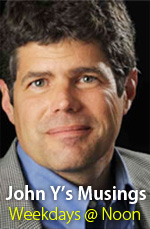 Yet I also felt a little neglected. Yet I also felt a little neglected.
Maybe the pharmacist just hadn’t completed “Customer service training” yet.
|
The Recovering Politician Bookstore
|
 Here’s the thing about toothpaste tubes. You can squeeze all you want on one part of the tube and the toothpaste will only pop up in another part of the tube. Many of today’s important systems operate much the same way.
Here’s the thing about toothpaste tubes. You can squeeze all you want on one part of the tube and the toothpaste will only pop up in another part of the tube. Many of today’s important systems operate much the same way. The student and the patient should be at the center of our redesign efforts in education and health care. We need to experiment at the systems level, trying new approaches to see what works. For instance, we’ve proven that innovation works at the school level with hundreds of successful charter schools across the country. Now we need to experiment at the district level to test new student centered system approaches that are not constrained by the way the current system operates. That is the only way we are going to learn what solutions can deliver value to the student at scale. The same thing is true in health care. We need to design and test patient centered system approaches that are more about well care than about sick care. We can’t get there by playing at the margins of today’s system. Squeezing today’s toothpaste tubes harder will not work.
The student and the patient should be at the center of our redesign efforts in education and health care. We need to experiment at the systems level, trying new approaches to see what works. For instance, we’ve proven that innovation works at the school level with hundreds of successful charter schools across the country. Now we need to experiment at the district level to test new student centered system approaches that are not constrained by the way the current system operates. That is the only way we are going to learn what solutions can deliver value to the student at scale. The same thing is true in health care. We need to design and test patient centered system approaches that are more about well care than about sick care. We can’t get there by playing at the margins of today’s system. Squeezing today’s toothpaste tubes harder will not work.














